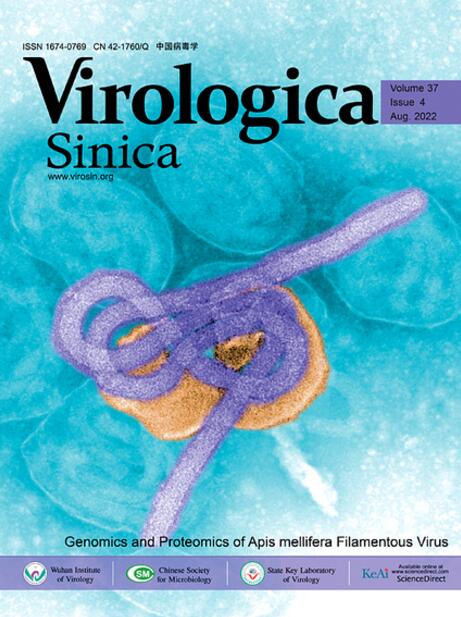Virome diversity in small mammals from south China: Insights into virus evolution, transmission, and ecology
IF 4
3区 医学
Q1 Medicine
引用次数: 0
Abstract
Mammals are critical reservoirs of human infectious diseases and the spillover of viruses is related to climate conditions. We conducted meta-transcriptomic sequencing of 226 mammals (bats, rodents, hedgehogs, and shrews) representing 20 species collected across eight cities in south China between 2018 and 2024. Samples included internal organs, oropharyngeal and anal swabs, and feces. We identified 63 vertebrate-associated viruses, including 34 novel viruses. Phylogenetic analysis revealed six viruses with potential infection risks to humans or domestic animals due to their close phylogenetic relationships with known pathogens. Cross-species transmission was observed in 14.3% (9/63) of viruses, shared by at least two host species, with bats, particularly Rhinolophus and Hipposideros, serving as key hubs for viral circulation and zoonotic spillover. Virome composition varied substantially among mammalian species and geographic regions (adonis test, R2 = 0.50, P = 0.001). Generalized linear models quantified the roles of host taxonomy, ecotypes, and meteorological factors in shaping viral diversity, demonstrating host taxonomy (at the order level) as a predominant role (25.70% deviance explained), followed by ecotypes (10.27% deviance explained). Phylogenetic analysis conducted using our betacoronavirus sequences, as well as betacoronavirus sequences derived from 2.0 × 104 bats sampled in China between July 2013 and March 2024, revealed that no betacoronaviruses exhibited closer phylogenetic relationships to SARS-CoV-2 than the known strains (e.g., RaTG13). These findings provide critical insights into virus evolution, transmission, and ecological determinants, which are essential for the prevention of emerging infectious diseases.
华南小型哺乳动物的病毒群多样性:对病毒进化、传播和生态学的见解。
哺乳动物是人类传染病的重要宿主,病毒的外溢与气候条件有关。研究人员对2018年至2024年间在中国南方8个城市收集的226种哺乳动物(蝙蝠、啮齿动物、刺猬和鼩鼱)进行了meta转录组测序。样本包括内脏、口咽和肛门拭子以及粪便。我们鉴定出63种脊椎动物相关病毒,包括34种新型病毒。系统发育分析发现6种病毒与已知病原体有密切的系统发育关系,对人类或家畜具有潜在的感染风险。在14.3%(9/63)的病毒中观察到跨物种传播,至少由两个宿主物种共享,其中蝙蝠,特别是犀牛和希波sideros,是病毒传播和人畜共患溢出的关键枢纽。病毒组组成在哺乳动物种类和地理区域之间存在显著差异(adonis R2 = 0.50, P = 0.001)。广义线性模型量化了宿主分类学、生态型和气象因素在塑造病毒多样性中的作用,表明宿主分类学(在目级)是主要作用(25.70%的偏差解释),其次是生态型(10.27%的偏差解释)。利用我们的冠状病毒序列以及2013年7月至2024年3月在中国采样的2.0 × 104只蝙蝠的冠状病毒序列进行的系统发育分析显示,没有一种冠状病毒与SARS-CoV-2的系统发育关系比已知毒株(例如RaTG13)更密切。这些发现为病毒进化、传播和生态决定因素提供了重要见解,这对预防新发传染病至关重要。
本文章由计算机程序翻译,如有差异,请以英文原文为准。
求助全文
约1分钟内获得全文
求助全文
来源期刊

Virologica Sinica
Biochemistry, Genetics and Molecular Biology-Molecular Medicine
CiteScore
7.70
自引率
1.80%
发文量
3149
期刊介绍:
Virologica Sinica is an international journal which aims at presenting the cutting-edge research on viruses all over the world. The journal publishes peer-reviewed original research articles, reviews, and letters to the editor, to encompass the latest developments in all branches of virology, including research on animal, plant and microbe viruses. The journal welcomes articles on virus discovery and characterization, viral epidemiology, viral pathogenesis, virus-host interaction, vaccine development, antiviral agents and therapies, and virus related bio-techniques. Virologica Sinica, the official journal of Chinese Society for Microbiology, will serve as a platform for the communication and exchange of academic information and ideas in an international context.
Electronic ISSN: 1995-820X; Print ISSN: 1674-0769
 求助内容:
求助内容: 应助结果提醒方式:
应助结果提醒方式:


